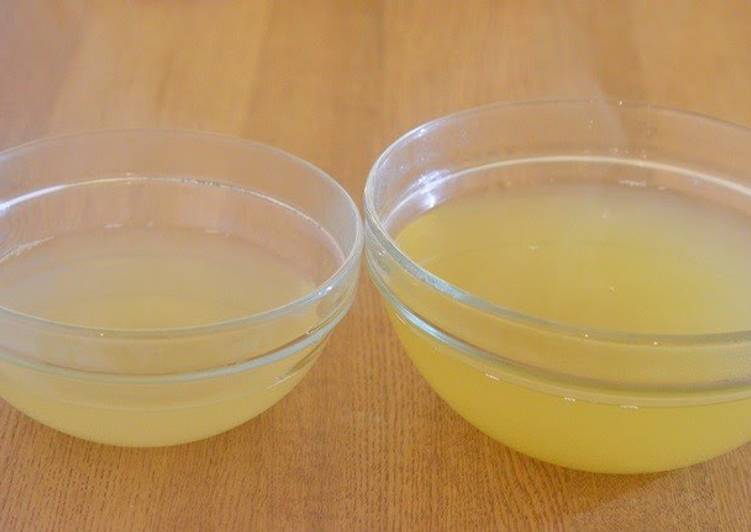
Hey everyone, it’s Drew, welcome to our recipe site. Today, we’re going to make a special dish, basic dashi stock (ichiban/first dashi, niban/second dashi). It is one of my favorites food recipes. This time, I’m gonna make it a little bit unique. This will be really delicious.
Great recipe for Basic Dashi Stock (Ichiban/First Dashi, Niban/Second Dashi). Make sure not to simmer the konbu seaweed or bonito flakes longer than necessary. If you want clear dashi, I recommend.
Basic Dashi Stock (Ichiban/First Dashi, Niban/Second Dashi) is one of the most favored of recent trending foods in the world. It’s easy, it is fast, it tastes delicious. It is enjoyed by millions every day. Basic Dashi Stock (Ichiban/First Dashi, Niban/Second Dashi) is something which I’ve loved my whole life. They’re fine and they look wonderful.
To get started with this recipe, we must prepare a few ingredients. You can have basic dashi stock (ichiban/first dashi, niban/second dashi) using 5 ingredients and 8 steps. Here is how you cook it.
The ingredients needed to make Basic Dashi Stock (Ichiban/First Dashi, Niban/Second Dashi):
- Prepare 15 grams Kombu
- Take 35 grams Bonito flakes
- Make ready 1 liter + 100 ml Water (for the ichiban/first dashi)
- Make ready 500 ml Water (for the niban/second dashi)
- Get 15 grams Additional bonito flakes (only if necessary)
Niban dashi (the second dashi) After the primary dashi comes the second brew dashi, called niban dashi. As the name suggests, this is simply made from the once-boiled kombu and katsuobushi that gets a second life in a milder flavoured dashi. How to make niban dashi: simply add the saved ingredients to cold water and bring to a boil. The Dashi Tiers Besides commercial-quality dashi, there is also the general niban (second) dashi, which consists of general-quality kombu and katsuobushi.
Steps to make Basic Dashi Stock (Ichiban/First Dashi, Niban/Second Dashi):
- Soak the konbu seaweed in water (for the ichiban/first dashi) overnight.
- Heat water and konbu seaweed from Step 1. When it comes to a boil, remove the konbu seaweed. Add extra water plus all the bonito flakes at once and bring to a boil. Turn off the heat as soon as it boils.
- When the bonito flakes sink to the bottom (in 2-3 minutes) either scoop out or strain the dashi through paper towels.
- Put the used konbu seaweed and bonito flakes in water for niban/second dashi and bring to a boil. Simmer over low heat for 5 minutes. If adding adding more bonito flakes for flavor, add 1/2 the amount used for the ichiban dashi.
- Store dashi you'll use right away in a pot (it'll keep for 2-3 days). To store dashi longer (up to 3 weeks) pour into ice trays, or into a plastic ziplock bag and freeze flat.
- Use ichiban-dashi for clear soups and miso soups, and other dishes that call for it. Use niban-dashi for simmered dishes and the like.
- I recommend simmering niban-dashi and konbu seaweed used for making dashi with vegetables in a pressure cooker. The dashi flavor penetrates the vegetables, and the konbu seaweed becomes soft and silky. You can enjoy a lot of vegetables this way.
- Try cooking daikon radish slices (with the sharp edges rounded off) with konbu seaweed, salt, and sugar in a pressure cooker for 10 minutes for a light and mild flavored dish.
Even in higher quality dashi, there exists different tiers of them. The ichiban (first) dashi combines both high-quality kombu and katsuobushi to produce a sweet, yet umami taste. Dashi is a very important component in Japanese cooking, like chicken or vegetable broth in American food. It has a savory taste ("Umami"), and that gives a lot of dishes and soups the base of the flavor. Ichiban Dashi uses fresh, new Kombu and Katsuo (Ichiban means first), so it has a stronger taste than regular Dashi.
So that’s going to wrap this up with this special food basic dashi stock (ichiban/first dashi, niban/second dashi) recipe. Thank you very much for your time. I’m confident that you will make this at home. There’s gonna be interesting food at home recipes coming up. Remember to save this page on your browser, and share it to your loved ones, colleague and friends. Thank you for reading. Go on get cooking!


